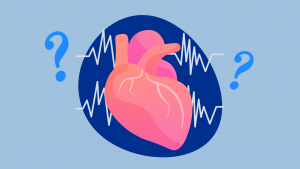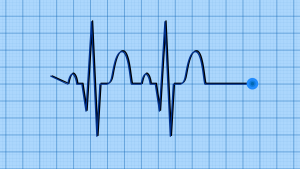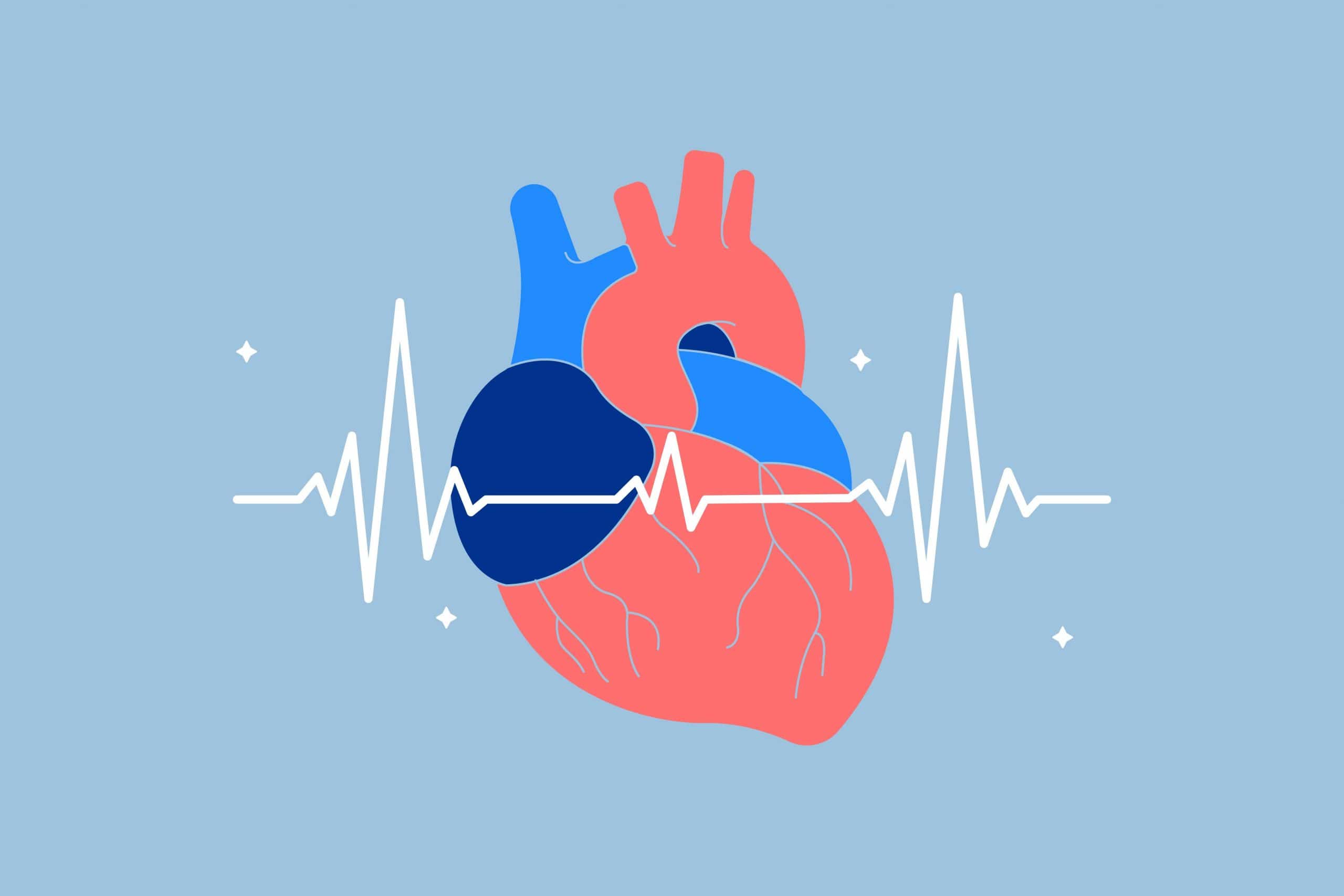Key Takeaways
- Heart Rate Variability (HRV): HRV measures the variation in time between each heartbeat, indicating how well the heart adapts to situations. It can be an essential metric for tracking physical and mental well-being.
- Sleep and HRV: HRV changes throughout sleep cycles, with lower HRV during non-REM sleep and higher HRV during REM sleep. A low HRV score during sleep can indicate sleep disorders or health issues.
- Factors Affecting HRV: Various factors, including exercise, stress, and sleep quality, influence HRV. Maintaining a healthy lifestyle, including regular exercise, good nutrition, and stress management, can improve your HRV score and overall heart health.
With modern technology, there’s a near-infinite amount of minutia we can watch. We wait for patterns to emerge that can help us see ways to improve.
For many of us, our lives have begun revolving around tracking our body’s processes. We track:
- How many steps do we take each day
- How long do we spend in each stage of sleep
- The number of calories we consume in a day
One of the latest processes to measure is heart rate variability. This isn’t a simple measurement of your heartbeat per minute. Instead, it’s a complex expression of how well your heart adapts to situations.
If you’re inside a medical office, your heart rate variability is likely measured with an electrocardiogram. This is the heart rate test where numerous wires are hooked up to your chest to collect data. However, people interested in measuring their heart rate variability at home have numerous apps and chest strap monitors that can get the job done.
What is Heart Rate Variability?
 As the term suggests,
heart rate variability is
Verified Source
Harvard Health
Blog run by Harvard Medical School offering in-depth guides to better health and articles on medical breakthroughs.
View source
a measurement of the variation in time between each heartbeat. In other words, it expresses how well the heart changes speeds throughout the day.
As the term suggests,
heart rate variability is
Verified Source
Harvard Health
Blog run by Harvard Medical School offering in-depth guides to better health and articles on medical breakthroughs.
View source
a measurement of the variation in time between each heartbeat. In other words, it expresses how well the heart changes speeds throughout the day.
For example, you may measure your heart rate and find it’s about 90 beats per minute. However, that doesn’t mean that every single heartbeat takes about ⅔ of a second. The interval between each heartbeat varies. In this same example, you may have ⅓ of a second between beats and later a full second between beats.
These increments between beats are called R-R intervals and are measured in milliseconds. The term “R-R intervals” comes from the heartbeat’s R-phase. These intervals are essentially the spikes you see on the results of an electrocardiogram (EKG) test. Verified Source Medline Plus Online resource offered by the National Library of Medicine and part of the National Institutes of Health. View source
“During the R phase, most of the heart is activated resulting in the greatest wave shown by the ECG recording,” according to a 2016 review on heart rate variability in humans. Verified Source National Library of Medicine (NIH) World’s largest medical library, making biomedical data and information more accessible. View source
The smaller the standard deviation in your R-R intervals, the lower your HRV score is. You may also see the term NN interval used instead of R-R intervals.
The variation in heart rate happens because of your autonomic nervous system, a body process beyond our conscious control. Your autonomic nervous system also regulates your blood pressure, along with your respiratory and digestive systems.
The autonomic nervous system can be broken down into two subsystems, your sympathetic and parasympathetic nervous systems. The sympathetic nervous system is in charge of your “flight-or-fight” responses and helps your body survive. Meanwhile, the parasympathetic nervous system enables you to relax.
Technically speaking, there is also a third subsystem. This is the enteric nervous system regulating your digestive system and bowel movements. However, this subsystem is relatively unimportant when discussing the ANS and HRV.
These subsystems operate thanks to the hypothalamus‘s input. The hypothalamus is the area of your brain that processes information and reacts to stimuli. Then, the hypothalamus relays signals to the body.
HRV represents the delicate balance the autonomic nervous system must maintain between its two components. When the sympathetic nervous system has greater influence, the heart speeds up and HRV decreases. Conversely, the parasympathetic influence slows down the heart and increases HRV.
When the autonomic nervous system is out of balance, the sympathetic nervous system can exceed its boundaries, affecting the body in numerous ways that include a low HRV score.
Essentially, the more variation there is between heartbeats, the more flexible and resilient your mind and body are. A low HRV score has been associated with depression, anxiety, and even increased chances of heart disease. Watching your HRV can help you track your emotional and behavioral well-being along with your physical health.
As a 2017 overview of heart rate variability puts it, “ a healthy heart is not a metronome.” Instead, the rhythms of your heart can and should vary as your body adapts to situational stimuli. “Beat-to-beat fluctuations are best described by mathematical chaos.”
Too much variance can indicate issues like atrial fibrillation, Verified Source Centers for Disease Control and Prevention (CDC) The United States’ health protection agency that defends against dangers to health and safety. View source the most common type of heart arrhythmia. Meanwhile, too little variance can signify increased stress or a bout of illness. It has also been tied to numerous medical conditions.
A low HRV has been associated with an increased risk of all-cause mortality. Reduced HRV is also tied to a decrease in survival odds of acute myocardial infarction, Verified Source Johns Hopkins Medicine University focused on medical research that produces thoroughly reviewed health articles. View source the medical term for a heart attack.
Heart Rate Variability and Sleep
When you sleep, your heart rate slows gradually. The average adult’s heart rate Verified Source Harvard Health Blog run by Harvard Medical School offering in-depth guides to better health and articles on medical breakthroughs. View source is between 60 and 100 beats a minute when their body is at rest.
As they fall asleep, their normal heart rate slows to its resting rate while the body’s core temperature falls and other muscles relax. When they enter the deeper sleep stages, their resting heart rate drops by about 20 to 30 percent.
Your HRV changes as you cycle through the different sleep stages. As you move through the non-REM or NREM sleep stages, your HRV drops overall, Verified Source American Heart Association (AHA) Funds cardiovascular medical research and promotes awareness about heart health. View source although the variance between individual beats can increase.
Once you move into the rapid eye movement or REM sleep stage, this gets flipped around. Researchers observed an increased overall variability in your heart rate but lowered beat-to-beat changes during REM sleep.
Your heart rate during REM sleep is a reflection of your dreams. A terrifying nightmare that gets your heart pumping or even just dreaming of being physically active can raise your heart rate. Similarly, your blood pressure during REM sleep can vary.
Heart rate variability is more of a symptom of how well you’re sleeping than a factor affecting your sleep quality. A patient’s HRV data has been used Verified Source National Library of Medicine (NIH) World’s largest medical library, making biomedical data and information more accessible. View source as part of the screening process for sleep disorders. HRV data has also been used to understand the effect sleep disorders have on daytime functioning.
A 2017 sleep study Verified Source National Library of Medicine (NIH) World’s largest medical library, making biomedical data and information more accessible. View source examined over 250 male and female staff members at a university hospital in Isfahan, Iran. The study’s purpose was to examine the relationship between every participant’s blood pressure and heart rate variability to sleep duration and sleep quality.
The study’s results showed that sleep duration and HRV had no significant relationship. However, high sleep onset latency (the time it takes one to fall asleep), poor sleep quality, and sleep medication use was associated with a higher heart rate.
Researchers concluded “that poor sleep quality is adversely associated with HRV” along with heart rate and blood pressure.
Similarly, your HRV during the day can be an indicator of how well you’ll sleep at night. A 2013 study Verified Source ScienceDirect One of the largest hubs for research studies and has published over 12 million different trusted resources. View source with university student volunteers had them fill out a sleep diary for a week and visit a laboratory once a day to collect heartbeat data with a digital interbeat interval recorder. The student volunteers were all considered healthy subjects in their early 20s.
This study concluded that a higher HRV during wakefulness is tied to greater sleep efficiency, Verified Source National Library of Medicine (NIH) World’s largest medical library, making biomedical data and information more accessible. View source a term typically defined as the ratio of time you spend asleep vs. the time you spend in bed.
A higher HRV is also tied to greater overall sleep quality.
These ties between higher HRV and better sleep efficiency and sleep quality remain true and significant even after accounting for demographic and psychological variables.
Sleep deprivation can also affect your HRV, along with a host of other heart issues. Verified Source Centers for Disease Control and Prevention (CDC) The United States’ health protection agency that defends against dangers to health and safety. View source Another 2013 study Verified Source National Library of Medicine (NIH) World’s largest medical library, making biomedical data and information more accessible. View source examined sleep-deprived physicians to gauge the autonomic regulation of the heart, with their data collecting methods including an HRV analysis.
The HRV analysis showed a “predominant sympathetic modulation and a parasympathetic withdrawal,” as part of a larger effect on the heart’s autonomic responses. Essentially, the sympathetic system had a greater effect, which tends to lead to accelerated heart rate.
Similarly, sleep disorders that affect your sleep efficiency also impact your HRV. A 2014 study noted Verified Source National Library of Medicine (NIH) World’s largest medical library, making biomedical data and information more accessible. View source obstructive sleep apnea (OSA) is associated with lower HRV. This reduction can be worsened if they have another condition that affects their HRV, such as metabolic syndrome.
According to the American Heart Association, Verified Source American Heart Association (AHA) Funds cardiovascular medical research and promotes awareness about heart health. View source metabolic syndrome Verified Source American Heart Association (AHA) Funds cardiovascular medical research and promotes awareness about heart health. View source is a diagnosis applied when a person has three or more of these conditions:
- High blood glucose
- Low levels of HDL cholesterol Verified Source American Heart Association (AHA) Funds cardiovascular medical research and promotes awareness about heart health. View source (healthy levels can protect against heart attack and stroke)
- High levels of triglycerides, the most common type of fat in the body
- A large waist circumstance
- High blood pressure
These five factors can increase your risk of heart disease, diabetes, stroke, and other health issues.
HRV has been suggested Verified Source National Library of Medicine (NIH) World’s largest medical library, making biomedical data and information more accessible. View source as a marker for obstructive sleep apnea. Also of note is that CPAP treatment may partially reverse the effects of sleep apnea on HRV.Taking HRV Measurements
 As we mentioned earlier, chest strap monitors are available on the market designed to give you an HRV measurement at home. However, because these monitors are largely unregulated, we can’t guarantee their accuracy.
As we mentioned earlier, chest strap monitors are available on the market designed to give you an HRV measurement at home. However, because these monitors are largely unregulated, we can’t guarantee their accuracy.
The physical and mental stresses of the day can affect your heart rate variability score. To best track your HRV, we suggest measuring it around the same time every morning after waking up. You can take a measurement every morning if you wish. However, a few times a week should be enough for a pattern to emerge. Behavioral sleep specialist, Dr. Alicia Roth, recommends using commercially available devices or with the assistance of your doctor or cardiologist.
Heart rate variability was first measured using short-term EKG tests. However, there are more than 20 ways to calculate HRV by mathematically manipulating R-R intervals, including:
- The SDNN index, with standard deviations of the normal mean R-R interval from 5-minute intervals in a 24 hours. The American Heart Association has criticized SDNN values as potentially unreliable because of the way data collection depends on the recording period.
- The pNN50 index is the number of times in an hour that consecutive R-R intervals differ by more than 50 milliseconds, as measured over 24 hours.
- The rMSSD index is the root-mean square of the difference of successive R-R intervals.
- The MAX-MIN method or the peak-valley quantification of HRV. This is calculated with the difference between the shortest R-R interval during the inspiration breathing phase Verified Source Medline Plus Online resource offered by the National Library of Medicine and part of the National Institutes of Health. View source (when you inhale) and the longest R-R interval during the expiration phase (when you exhale).
These are time domain measures that essentially examine how heartbeats change over time. However, there are also frequency-domain measurements that use spectral analysis of an EKG test to determine an HRV score.
The task force established by the European Society of Cardiology and the North American Society of Pacing recommends 24-hour measurements for long-term analysis and five minutes for short-term recordings. Naturally, these short-term recordings are easier to perform.
How to Keep Your Heart Healthy
 To have a good heart rate variability score, you must have a
healthy heart
Verified Source
National Library of Medicine (NIH)
World’s largest medical library, making biomedical data and information more accessible.
View source
overall. A balanced diet and daily exercise can help you manage your weight and keep your heart in fighting form. On the other hand, obesity increases your risk of
coronary heart disease
Verified Source
National Library of Medicine (NIH)
World’s largest medical library, making biomedical data and information more accessible.
View source
and other medical conditions.
To have a good heart rate variability score, you must have a
healthy heart
Verified Source
National Library of Medicine (NIH)
World’s largest medical library, making biomedical data and information more accessible.
View source
overall. A balanced diet and daily exercise can help you manage your weight and keep your heart in fighting form. On the other hand, obesity increases your risk of
coronary heart disease
Verified Source
National Library of Medicine (NIH)
World’s largest medical library, making biomedical data and information more accessible.
View source
and other medical conditions.
Regularly performing moderate to vigorous physical activity can strengthen the heart muscle, Verified Source Johns Hopkins Medicine University focused on medical research that produces thoroughly reviewed health articles. View source helping it to pump more blood and deliver more oxygen through the body with a single beat. This increased efficiency lowers your resting heart rate.
It’s also vital to watch your blood pressure and cholesterol levels. High blood pressure, Verified Source National Library of Medicine (NIH) World’s largest medical library, making biomedical data and information more accessible. View source also known as hypertension, and high blood cholesterol Verified Source National Library of Medicine (NIH) World’s largest medical library, making biomedical data and information more accessible. View source are tied to an increased likelihood of heart disease.
It’s essential to monitor your stress and anger levels, as these can lead to high blood pressure, indirectly increasing your chances of heart disease. Talking with a professional counselor or joining a stress management program can help you better understand and manage your emotions, as can more individualized activities like exercise and relaxation techniques.
There are some unavoidable risk factors for heart disease, such as:
- Your age. Older individuals in their 40s and 50s have a higher risk of heart disease.
- Your birth gender. Females tend to develop heart disease later in life than males. Menopause can dramatically increase their risk of heart disease.
- Your family or genetic history. Some people have a genetic predisposition for heart disease.
Similarly, there are uncontrollable factors that determine what your heart rate variability is, such as diabetes mellitus. This is the full name for what is commonly known as diabetes, a condition where the body doesn’t produce enough insulin to control blood sugar.
Diabetic patients with chronic complications tend to have lower HRV parameters, Verified Source National Library of Medicine (NIH) World’s largest medical library, making biomedical data and information more accessible. View source which means their “picture of health” may look different from those who don’t have diabetes.
Working to bring what you can under your control can help to mitigate the unavoidable risk factors, such as getting a good night’s sleep and minimizing how sleep deprivation affects the heart.

Getting a Better Night of Rest
Maintaining a healthy HRV isn’t the only way to get a good night’s sleep. We recommend following our sleep hygiene tips to improve rest.
Have a Regular Schedule
 Sticking to a daily sleep schedule is a key part of getting enough sleep, which means waking up and falling asleep at roughly the same time every day. Yes, that includes days off, too. Taking steps to reset your inner clock can help you start a healthy sleep schedule.
Sticking to a daily sleep schedule is a key part of getting enough sleep, which means waking up and falling asleep at roughly the same time every day. Yes, that includes days off, too. Taking steps to reset your inner clock can help you start a healthy sleep schedule.
You can double-check if you’re falling asleep at a good time by using our sleep calculator. By entering the time you plan to wake up, you can see a set of several potential bedtimes, ranging from ‘acceptable’ to ‘ideal.’
One important step to take to ensure you’re sleepy at bedtime? Turn off your screens as it gets late into the evening, at least an hour before bed. Blue light exposure from screens can feel like daylight to your eyes, can
Evaluate Your Mattress
 We also recommend checking how comfortable your mattress feels. Does it feel lumpy in spots, or do you feel like your torso is sinking too far? As a mattress ages, it loses its shape and support and causes significant discomfort. If you’re no longer getting a good night’s rest, it may be time to replace your mattress.
We also recommend checking how comfortable your mattress feels. Does it feel lumpy in spots, or do you feel like your torso is sinking too far? As a mattress ages, it loses its shape and support and causes significant discomfort. If you’re no longer getting a good night’s rest, it may be time to replace your mattress.
Even if your mattress isn’t old, it may not be the best mattress for your sleep needs. For example, a too-firm or too-soft mattress can make it more difficult to recover while sleep due to the strain it places on the body. The right firmness for you will depend mostly on your favorite sleep position and body type.
Sleeping Position
There are three sleep positions, with most favoring their sides and others sleeping on their backs or stomachs. Each position has a different recommended firmness range for those interested in having the most comfortable mattress.
Mattresses for side sleepers can range from soft to medium, depending on the desired mix of plush cushion and support a sleep wants. Softness is essential in a bed for side sleepers because the surface hugs the shoulders and hips, where pressure tends to build up in a side sleeper’s body.
Back sleepers need a mattress with less softness, as they can develop back pain if their torsos sink too far into the surface. A mattress for back sleeping should have a medium-firm to firm feel, though a medium mattress is acceptable for back sleepers that enjoy softer mattresses.
For stomach sleepers, a firm mattress is necessary to sleep well at night. Unless you have a proper mattress for stomach sleeping, you are likely to wake up with a sore back from gravity pushing your abdomen too far into the mattress.
Anyone who moves between two or all three of these positions is known as a combination sleeper. Medium to medium-firm mattresses for combination sleeping are best because they can provide adequate comfort to all three positions.
Body Type
Now, as for body type, how much you weigh can affect how hard you push down on the mattress. People who weigh less will simply press down with less force than a heavier sleeper will, so a mattress needs to be able to push back or conform as needed.
Mattresses for heavy people should be in the firmer end of a sleeper’s recommended range for their position. Too-soft surfaces can feel unsupportive and cause discomfort.
Conversely, mattresses for petite or lightweight sleepers should be in the softer end of a position’s recommended range. If a mattress can’t hug the body swiftly, then the surface is likely to feel too firm to a smaller sleeper.
Coolness
It’s also important to see how well your mattress stays cool at night. Any mattress can absorb your ambient body heat, and if this heat is allowed to build up it can create discomfort, leaving you to wake up sweaty in the middle of the night. A cooling mattress promotes undisturbed rest.
Even if your mattress tends to grow warm, you can still stay cool at night with lightweight bedding and pajamas.
Set Up Your Bedroom for Success
 Setting up your bedroom for better sleep is also highly important. If your bedroom is too cluttered, too stimulating and filled with potential distractions, or too depressive, it can make it difficult to fall asleep.
Setting up your bedroom for better sleep is also highly important. If your bedroom is too cluttered, too stimulating and filled with potential distractions, or too depressive, it can make it difficult to fall asleep.
Even the color of your bedroom walls can influence how challenging or easy it is to fall asleep quickly at night. Several of our guides to better bedroom setups include:
- Best and Worst Bedroom Colors for Sleep
- How a Tech-Free Bedroom Creates Smarter Sleep
- Creating a Calm, Clutter-Free Bedroom
- Fire Safety Tips for the Bedroom
- How to Cool Down Your Bedroom
Many sleepers also find their rest improves if they avoid over-using their bedroom during the day. For example, if you work from home, it’s best to avoid the temptation of working from bed or even working at a desk in the bedroom. Doing so can cause workday concerns to leak into your mind more easily when you’re trying to unwind for bed.
Frequently Asked Questions
How does sleep affect heart rate variability?
For the most part, your heart rate variability should be lower during sleep than when you’re awake. The heart slows as most of the body goes inactive, after all. The exception to this is REM sleep, when your brain grows more active and the body accordingly “wakes up” more. Still, your heart rate during REM sleep shouldn’t exceed what it is during the day.
While the non-REM stages have lowered HRV overall, they also are correlated with higher beat-to-beat variability. Conversely, REM sleep is associated with greater overall variability but a reduced beat-to-beat variability.
What is a good heart rate variability while sleeping?
Because heart rate variability is specific to each individual, giving a specific number of recommended beats per minute is difficult. Generally, your heart rate while sleeping should be 20 to 30 percent below your resting heart rate during the day. As you measure your HRV over time, you should get an idea of what your baseline HRV is and what’s healthy for you.
However, as a general rule of thumb, your sleeping HRV score should be lower than your wakeful HRV score. What if the numbers are similar or your sleeping HRV score is higher than your daytime HRV score? You may want to speak with your doctor about possible mental or physiological factors affecting your HRV, such as anxiety.
When should HRV be measured?
Harvard Health recommends checking your HRV in the morning after waking up. To do so, they suggest buying a chest strap heart monitor and using an app to analyze your data.
Try to measure HRV while you’re at rest, not after exercising or any other activity that can significantly affect your baseline HRV reading. Do this a few times a week and note the results so you can track any changes.
What if my HRV is low?
A single low HRV or a few low scores in a row isn’t necessarily a cause for concern. Your HRV may be low after working out, for example. HRV scores also naturally decrease as you age.
However, correlations have been found between reduced HRV scores to death in people with myocardial infarction (MI) and fatal ventricular arrhythmia. Are concerned your HRV is abnormally low? Speak with a medical professional for an informed opinion.
How do I improve my HRV score?
A high HRV score is tied to good overall heart health, so take steps to make sure you’re keeping your heart in peak condition. Naturally, you should strive to eat healthily and exercise regularly. Along with your HRV scores, watch your weight, cholesterol, and blood pressure levels to make sure you’re in the healthy range.
Lastly, you should practice methods for coping with stress to keep yours at manageable levels. If need be, speak to a doctor about ways to get conditions like anxiety under your control.
Do You Understand Heart Rate Variability?
Heart rate variability can be an important indicator of your mental and physical health. Your HRV can also predict how well you’re sleeping at night and warn you if you have a medical condition. Investing in a well-reviewed HRV monitor can help you make greater strides in your health journey.
About the author
April Mayer is a sleep expert and writer with a degree in exercise physiology. She has dedicated her career to exploring the relationship between sleep and productivity. Her insightful articles, such as "The Surprising Way Your Mood Might Be Messing With Your Productivity" and "Wake Up to More Productive Mornings," have been featured in reputable publications like Forbes, Greatist, Real Homes, Thrillist, Tom's Guide, and Eat This, Not That. With a passion for helping others lead more productive lives through restful sleep, April offers valuable expertise on foods and vitamins for better sleep. As a trusted member of the Early Bird team since March 2020, she continues to provide informative and well-researched content.
View all posts




